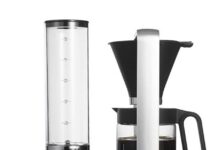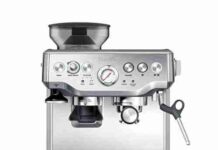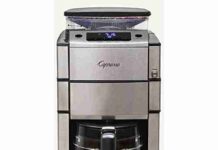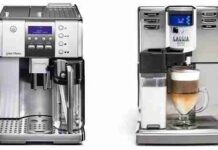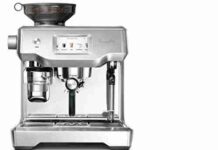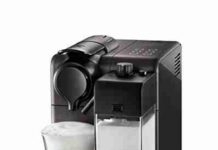Ah, the beloved coffee maker, always faithfully serving up our much-needed caffeine fix each morning. But what do you do when it suddenly refuses to brew? That frustrating feeling of staring at a half-empty cup and wondering what went wrong can be maddening. Don’t fret, dear coffee enthusiasts, for we have the answers you seek. In this article, we will explore the common issues that may be plaguing your precious coffee maker and provide you with simple yet effective solutions to get that brewing magic flowing again. Prepare to bid farewell to those disappointing mornings, as we unravel the mysteries of fixing a coffee maker that won’t brew.
This image is property of cdn.shopify.com.
Inspecting the Power Supply
Checking the Power Outlet
When encountering a coffee maker that won’t brew, the first step is to inspect the power supply. Start by checking the power outlet to ensure that it is functioning properly. It’s possible that the coffee maker is not receiving power due to a faulty or disconnected power outlet. We recommend plugging in another device to the outlet to confirm if it is working. If there is power in the outlet and the coffee maker still won’t brew, then the issue may lie elsewhere.
Ensuring the Power Cord is Plugged In
Next, make sure that the power cord of the coffee maker is securely plugged into the outlet. Sometimes, the cord may become loose or accidentally disconnected, preventing the coffee maker from receiving power. Carefully examine the connection between the power cord and the outlet, ensuring that it is properly connected. If the power cord is secure and the coffee maker still won’t brew, additional troubleshooting steps are necessary.
Verifying the Power Switch
Another potential cause for a coffee maker that won’t brew is a faulty power switch. Verify that the power switch is in the “On” position. Occasionally, the switch may be accidentally turned off or become stuck in between positions. Toggle the switch back and forth a few times to eliminate any potential issues with the switch.
Examining the Fuse
If all previous steps have been checked and the coffee maker still won’t brew, it may be necessary to examine the fuse. The fuse is typically located within the coffee maker and serves as a safety measure to protect against electrical failures. Carefully open the coffee maker according to the manufacturer’s instructions and inspect the fuse. If the fuse appears to be damaged or blown, it will need to be replaced. Contacting a professional technician may be necessary if you are uncomfortable with replacing the fuse yourself.
Troubleshooting the Water Supply
Checking the Water Reservoir
If the power supply is not the issue, it’s important to troubleshoot the water supply. Start by checking the water reservoir of the coffee maker. Ensure that it is filled with an adequate amount of water. Some coffee makers have a minimum or maximum fill line, so be sure not to exceed or fall below those levels. If the water reservoir is empty or below the required level, refill it accordingly.
Inspecting the Water Filter
Another common issue that can cause a coffee maker to not brew is a clogged water filter. Check the water filter and clean or replace it if necessary. Over time, mineral deposits and coffee grounds can accumulate, obstructing the flow of water. Cleaning the filter or replacing it, as recommended by the manufacturer, can help resolve this problem and restore the brewing functionality of the coffee maker.
Cleaning the Water Tube
A clogged or dirty water tube can also prevent a coffee maker from brewing. Carefully remove the water tube, as instructed in the coffee maker’s manual, and clean it thoroughly. Mineral deposits and other debris can accumulate inside the tube over time, restricting the flow of water. By cleaning the water tube, you can ensure that the water supply to the brewing mechanism is unobstructed.
Examining the Water Pump
If the water pump is not functioning properly, the coffee maker may have difficulty brewing. Inspect the water pump for any signs of damage or blockage. Ensure that the pump is clean and in good working condition. If there are any issues with the water pump, it may need to be repaired or replaced. Consider contacting a professional technician for assistance with repairing or replacing the water pump.
This image is property of i.ytimg.com.
Troubleshooting the Brewing Mechanism
Verifying the Brewing Button
After addressing the power and water supply issues, it is important to troubleshoot the brewing mechanism of the coffee maker. Start by verifying that the brewing button or switch is working correctly. Ensure that it is not loose or stuck in a position that prevents it from activating the brewing process. If the brewing button seems faulty, it may require replacement or repair.
Cleaning the Coffee Filter
A clogged coffee filter can impede the brewing process and result in a coffee maker that won’t brew. Remove the coffee filter and clean it thoroughly. Rinse off any accumulated residue or coffee grounds that may be obstructing the flow of water. After cleaning the coffee filter, securely place it back in the coffee maker.
Checking the Brew Basket
The brew basket is another component that should be inspected when troubleshooting a coffee maker that won’t brew. Ensure that the brew basket is properly positioned in the coffee maker. If it is misaligned or not securely in place, it can prevent the coffee maker from brewing. Adjust the position of the brew basket as necessary, ensuring a secure fit.
Examining the Drip Stop Valve
The drip stop valve plays a crucial role in controlling the flow of brewed coffee into the carafe. If this valve is malfunctioning, it may result in coffee spilling or not being properly dispensed. Carefully examine the drip stop valve for any signs of damage or blockage. Clean it thoroughly to remove any debris that may be interfering with its functionality. If the drip stop valve is severely damaged, it may need to be repaired or replaced by a professional.
Cleaning and Descaling
Cleaning the Coffee Maker
Regular cleaning is essential for maintaining the optimal performance of a coffee maker. Over time, residue, mineral deposits, and oils from coffee can accumulate in various parts of the machine, affecting its ability to brew properly. Follow the manufacturer’s instructions for cleaning your specific coffee maker model. Typically, this involves running a cleaning solution or a mixture of vinegar and water through the brewing cycle to remove any buildup. Additionally, clean the exterior of the coffee maker using a damp cloth to remove any stains or dirt.
Descaling the Coffee Maker
Descaling is a crucial step in maintaining a coffee maker’s efficiency and prolonging its lifespan. Over time, mineral deposits can build up inside the machine, particularly in areas that come into contact with water. Descaling removes these deposits, allowing the coffee maker to function optimally. Follow the manufacturer’s instructions for descaling your specific coffee maker, as the process may vary depending on the model. Typically, it involves using a descaling solution, vinegar, or a citric acid mixture to remove the mineral buildup.
This image is property of i.ytimg.com.
Resolving Issues with the Grinder
Inspecting the Grinder Mechanism
If your coffee maker is equipped with a grinder and it won’t brew, start by inspecting the grinder mechanism. Ensure that it is clean and free of any blockages. Remove any obstructions or accumulated coffee grounds that may prevent the grinder from operating correctly. If the grinder appears damaged, contact a professional technician for repair or replacement.
Cleaning the Grinder
Regular cleaning of the grinder is essential for maintaining its functionality. Coffee oils and residue can accumulate in the grinder, affecting the quality of the grind and ultimately the brewing process. Follow the manufacturer’s instructions for cleaning the grinder, as the process may vary depending on the model. Typically, it involves disassembling the grinder, removing any remaining coffee grounds, and wiping the components clean. Be sure to reassemble the grinder correctly after cleaning.
Adjusting the Grinder Settings
If the coffee maker is not brewing properly, it may be necessary to adjust the grinder settings. The grind size directly affects the extraction process and the overall taste of the coffee. Experiment with different grind settings to find the optimal one for your preferred brewing method. Reference the coffee maker’s manual for guidance on adjusting the grinder settings.
Fixing Temperature Issues
Checking the Heating Element
Temperature issues can significantly impact the brewing process and the quality of the coffee. Start by checking the heating element of the coffee maker. Ensure that it is clean and free of any debris or mineral deposits. Carefully inspect the element for any signs of damage or malfunction. If the heating element is compromised, it may need to be repaired or replaced by a professional.
Cleaning the Heating Plate
The heating plate, also known as the warming plate, should be regularly cleaned to ensure that it functions properly. Over time, coffee residue and oils can accumulate on the plate, affecting its ability to heat the coffee. Disconnect the coffee maker from the power source and allow the heating plate to cool completely. Wipe the plate with a damp cloth to remove any residue or stains.
Examining the Thermostat
If the coffee maker is still experiencing temperature issues, it may be necessary to examine the thermostat. The thermostat regulates the brewing temperature and ensures that it remains at the appropriate level. If the thermostat is faulty or malfunctioning, the brewing temperature may be inconsistent or incorrect. Contact a professional technician for assistance with repairing or replacing the thermostat.
This image is property of i.ytimg.com.
Addressing Display and Control Problems
Inspecting the Display Screen
If the coffee maker has a digital display screen and is experiencing issues, the first step is to inspect the screen. Ensure that it is clean and free of any visible damage or cracks. Sometimes, a screen may become unresponsive or show error messages when not functioning correctly. If the display screen appears damaged or malfunctioning, consider contacting customer support or a technician for assistance.
Resetting the Control Panel
Occasionally, issues with the control panel can prevent a coffee maker from brewing. To troubleshoot this, try resetting the control panel. Refer to the coffee maker’s manual for instructions on how to perform a reset. This can help resolve any minor glitches or software errors within the control system.
Checking the Buttons and Knobs
Any issues with the buttons or knobs on the coffee maker can hinder its brewing functionality. Make sure that all buttons and knobs are intact, clean, and responsive. If a button or knob appears loose or broken, it may need to be repaired or replaced. Contact the manufacturer or a professional technician for assistance with repairing or replacing any faulty components.
Reprogramming the Coffee Maker
Resetting the Coffee Maker
If the coffee maker is still not brewing correctly, it may be necessary to reset the entire machine. Resetting the coffee maker can restore it to its original factory settings, eliminating any software or programming issues that may have occurred. Consult the coffee maker’s manual for detailed instructions on how to perform a reset.
Adjusting the Settings
Once the coffee maker has been reset, it is important to adjust the settings as needed. This includes setting the desired brewing strength, adjusting the water volume, or customizing any other specific preferences. Refer to the coffee maker’s manual for guidance on how to adjust the settings to your liking.
Performing a Factory Reset
If all troubleshooting steps have been followed and the coffee maker still won’t brew, it may be necessary to perform a factory reset. This will revert the coffee maker to its original settings, erasing any customized preferences or programmed instructions. Follow the manufacturer’s instructions carefully to perform a factory reset. If the coffee maker continues to exhibit issues, professional help may be required.
This image is property of guide-images.cdn.ifixit.com.
Getting Professional Help
Contacting Customer Support
If all attempts to fix the coffee maker have been exhausted and it still won’t brew, reaching out to customer support is a viable option. Contact the manufacturer’s customer support line for assistance. Provide them with the details of the issue, any troubleshooting steps you have already taken, and the model and serial number of the coffee maker. They may be able to provide additional guidance or recommend further steps to resolve the problem.
Seeking Assistance from a Technician
For more complex issues or those requiring specialized knowledge, it may be necessary to seek assistance from a professional technician. They have the expertise and tools to diagnose and repair coffee makers. If the coffee maker is still under warranty, contact the manufacturer for warranty information and potential repair options. If not covered under warranty, search for reputable appliance repair services in your area.
Preventing Future Issues
Regular Cleaning and Maintenance
To prevent future issues with your coffee maker, establish a regular cleaning and maintenance routine. Clean the coffee maker, including all removable parts, on a regular basis. Follow the manufacturer’s instructions for cleaning, descaling, and general maintenance. Regular removal of coffee residue, mineral deposits, and other debris will keep your coffee maker in optimal condition and reduce the likelihood of brewing problems.
Using Filtered Water
Water quality can impact the functionality and lifespan of a coffee maker. Using filtered water can help reduce mineral buildup and prevent clogs in the machine. Additionally, it can improve the taste of the brewed coffee. Consider investing in a water filtration system or use filtered water from a pitcher or faucet mount filter.
Proper Storage and Handling
Properly storing and handling the coffee maker is crucial for its longevity and performance. When not in use, store the coffee maker in a clean and dry location. Avoid exposing it to excessive moisture, heat, or extreme temperatures. Handle the coffee maker with care, following the manufacturer’s guidelines for safe operation. By maintaining proper storage and handling practices, you can prolong the lifespan of your coffee maker and minimize the risk of brewing issues.








